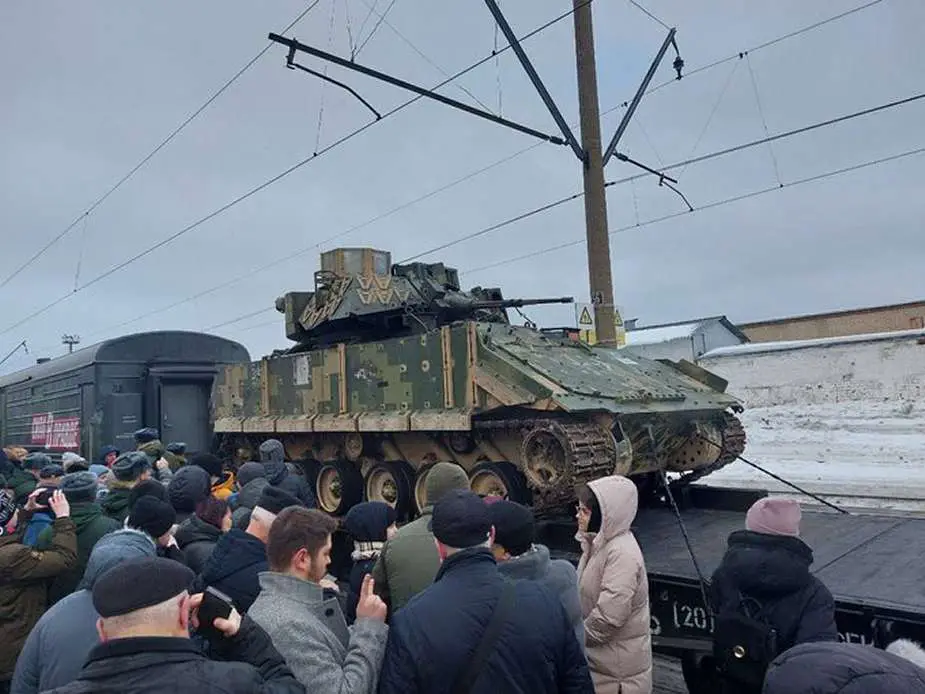Russia captures US Bradley IFV in Ukraine and analyzes its combat capabilities
In February 2024, images of a captured intact US Bradley M2A2 infantry fighting vehicle, with its vital equipment removed, circulated on Russian social networks. This reflects the Russian authorities' intention to study technologies developed by NATO militaries. This was not the first time, as in July 2023, photos of a captured Swedish CV9040 IFV, whose equipment had also been analyzed, surfaced
Follow Army Recognition on Google News at this link

US M2A2 Bradley captured in Ukraine by Russian forces (Picture source: Russian social media)
The capture of the US Bradley M2A2 by the Russian army could have several implications and uses. Firstly, studying a vehicle designed for NATO troops like the Bradley M2A2 and the Swedish CV9040 could provide the Russian military with valuable intelligence on Western militaries' latest technologies, engineering, and design principles. This information could be used to identify strengths and weaknesses in the vehicles' design, tactics, and operational capabilities.
Analyzing these captured vehicles could help Russian engineers identify vulnerabilities or weaknesses in the vehicles' armor, sensors, and electronic systems. This knowledge would allow them to develop effective countermeasures to improve the survival of their armored vehicles and strengthen their defense against similar platforms used by potential adversaries. It is also very likely that the Russians will develop new weapons capable of destroying Western vehicles.
Furthermore, the Russian military might be interested in integrating some of the advanced features or design concepts found in the Bradley M2A2 IFV and CV 9040 IFV into their armored vehicle programs. By capturing and examining the vehicle, they could learn about innovations in areas such as crew protection, mobility, firepower, and situational awareness, potentially influencing the development of their future armored vehicles.
Additionally, these captures of Western combat vehicles allow them to train their troops on how to operate, maintain, and engage such vehicles effectively. Familiarity with a potential adversary's equipment can provide an advantage in real combat scenarios.
This could also impact deterrence, as a thorough understanding of NATO capabilities by Russia could reduce the technological and tactical advantage normally held by Western forces.
In response to these technology leaks, NATO and its members could take several steps to mitigate the impact of such losses. Firstly, they could accelerate the development of new technologies and the upgrading of existing systems to outpace the countermeasures developed by Russia. This could include improving stealth, cyber resilience, and electronic countermeasure capabilities of military equipment.
Secondly, NATO could strengthen its operational procedures to minimize the risk of capturing sensitive equipment, such as using emergency destruction procedures for sensitive material about to be captured.
Finally, increasing investments in training and simulations to prepare troops to face updated adversary tactics and technologies could also help maintain NATO's strategic advantage.
Just as Russia analyzes Western material, NATO also recovers and studies Russian military equipment to understand its technologies and develop countermeasures. A notable example is the R-37M air-to-air missile, whose components were recovered in February 2023 in Ukraine and handed over to British intelligence. This very long-range missile is examined to allow NATO forces to adapt their defenses against advanced aerial threats and design systems capable of countering such weapons.
The exchange of technological blows between NATO and Russia, especially through the reverse engineering of captured military equipment, raises the question of who has the most to lose in this war of espionage and innovation. Does access to adversary technologies significantly improve defensive and offensive capabilities, or does it open the door to strategic vulnerabilities? The balance between gaining a tactical advantage and revealing one's weaknesses remains delicate, illustrating the complexity of modern warfare where information and technology are fronts just as critical as physical battlefields.
- Hits: 3574
















